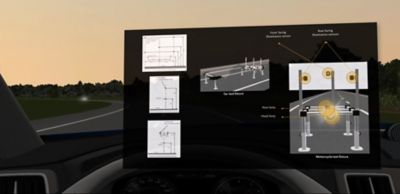-
United States -
United Kingdom -
India -
France -
Deutschland -
Italia -
日本 -
대한민국 -
中国 -
台灣
-
Ansys is committed to setting today's students up for success, by providing free simulation engineering software to students.
-
Ansys is committed to setting today's students up for success, by providing free simulation engineering software to students.
-
Ansys is committed to setting today's students up for success, by providing free simulation engineering software to students.
-
Contact Us -
Careers -
Students and Academic -
For United States and Canada
+1 844.462.6797
ANSYS BLOG
March 25, 2024
Win the Race for Intelligent ADB Headlights with Ansys AVxcelerate Headlamp
The software supports NHTSA FMVSS 108 ADB Regulation Virtual Certification
Headlamp technology has come a long way. Additional enhancements, such as the continuous engagement of high beams in low-visibility night conditions, are a great example of how manufacturers are making the drive safer. Specifically, adaptive driving beam (ADB) headlamps can bathe the road with a steady stream of bright light without blinding oncoming traffic.
It's only recently, though, that U.S. safety regulators have green-lighted this technology. However, there are still obstacles to adoption. That's because the level of automatic headlamp perception and detection testing needed for validation presents numerous challenges for original equipment manufacturers (OEMs) in the U.S.
Now for some good news. Recent improvements in Ansys AVxcelerate Headlamp 2024 R1 enable OEMs to rise to a new level of regulatory requirements. This enhancement is part of a software solution that enables lighting software engineers to test-drive their control software — combined with their headlamp designs — reliably in a virtual environment, thanks to optical properties and real-time, physically-accurate optical simulation.
New Lighting Rules Demand New Optical Solutions
With the FMVSS 108 regulation, there have been some recent changes in the National Highway Traffic Safety Administration’s (NHTSA's) lighting standard to enable ADB headlamp certification. It's defined within the context of any technology that actively modifies a vehicle's headlamp beams to deliver greater illumination without glaring at other vehicles — specifically lamps, reflective devices, and associated equipment.
"For OEMs, it's also one of the most complex regulations known in the headlamp regulatory space," says Lionel Bennes, lead product manager for AVxcelerate products at Ansys. "Passing the FMVSS 108 ADB regulation virtually requires new test tracks and a new test protocol. It also involves very specific traffic targets and is quite expensive to go through because it requires a lot of trial-and-error cycles."
Another layer of complexity is added when the ADB system is considered as a whole, taking into account the system’s perception performance and latency, as well as optical performances against real-world headlights targets (versus lab-controlled stimuli for other regulations).
Authorizing intelligent headlamps in the U.S. based on this new regulation presents challenges for OEMs and tier one suppliers facing this constantly evolving technology. A strategic improvement in AVxcelerate Headlamp 2024 R1 enables OEMs to accurately assess cutting-edge developments like ADB in headlamp design, according to these regulatory standards.
To give additional context, the FMVSS 108 ADB regulation thoroughly assesses the performance of intelligent headlamps for glare reduction in different kinds of scenarios involving traffic in both directions. Consequently, passing the FVMSS 108 ADB regulation is quite challenging and expensive, as achieving compliance requires testing around a lot of trial-and-error cycles — which, realistically, most tier ones and OEMs cannot afford on a test track.

AVxcelerate Headlamp testing for FMVSS 108 Regulation
Ansys Sets the Standard for Regulatory Compliance
With AVxcelerate Headlamp, the FMVSS 108 ADB regulation can now be passed virtually. The tool considers optical design performance to make sure that the illuminance thresholds are not crossed. It also assesses ADB perception and intelligence, including software performance and latency. By providing a virtual version of this regulation, AVxcelerate Headlamp can save both time and cost for OEMs and improve efficiency during development to speed up new ADB technologies to market.
AVxcelerate Headlamp FMVSS 108 ADB regulation-specific improvements include:
- Built-in regulation-defined trajectories that run automatically.
- Regulation-defined targets (for trucks, cars, and motorbikes) and lighting systems.
- Simulation runtimes at 100 Hz simulation steps, as per the regulation requirements.
- Final report generation with detailed illuminance plots for each test section, as well as a summary highlighting pass or fail for each test scenario.
Additionally, the software uses targets equipped with lighting systems on the market that are very well specified in the regulation text. Reproducing the exact trajectories, scenarios, and vehicle targets specified by the FMVSS 108 ADB regulation in a simulation environment results in fully accurate testing.
The capability to pre-validate the proper behavior of an ADB system against the FMVSS 108 regulation in a simulation environment is a strong advantage in a very competitive market. Users can perform a high number of trial-and-error simulations, then analyze and correct issues with the help of the detailed measurement report generated at almost no cost against real testing.
The Latest Release is Available Now
Of course, any opportunity to sort through and streamline the automotive regulatory approval process is a big win for OEMs and tier one suppliers. If you're faced with regulatory pressures like these during headlamp development and design, consider the latest release of Ansys AVxcelerate Headlamp simulation software in 2024.











